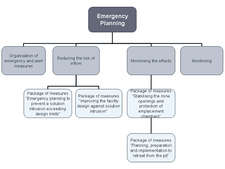Objective of emergency planning
As the operator of the Asse II mine mining and nuclear facility, the BfS is obliged to take sufficient precautions against possible operational disruptions or incidents in the facility. According to the mining requirements, the BfS has developed an emergency plan according to § 11 ABBergV. In particular, this plan regulates the emergency and alarm organisation.
Provisions for emergency preparedness
At least since 1988, there has been an inflow of saline solutions into the Asse II mine. Salt rock and overburden continue to deform. It cannot be ruled out that the inflowing volumes increase to the extent where this can no longer be controlled. Special emergency preparedness measures need to be taken for this case in particular (the case of a design-exceeding inflow of saline solution – i.e. an inflow of saline solution the facility has not be designed for, despite of all safety measures).
In order to minimise the risks resulting from a design-exceeding inflow of saline solutions,
- measures need to be taken that reduce the probability of occurrence of an uncontrollable inflow of saline solution, and
- suitable measures need to be taken that reduce the consequences of the event in case it occurs nevertheless.
Components of emergency planning
The central components of nuclear emergency planning thus consist of
- measures to reduce the probability of occurrence and
- measures to minimise the consequences of an uncontrollable inflow of saline solution.
Reducing the probability of occurrence
The filling of roof clefts reduces the deformation of the rock. This is one element to reduce the probability of occurrence of an uncontrollable inflow of saline solution. Other measures include e.g.
- sealing measures from outside,
- improvement of the facility design by e.g. Increasing the storage capacity and pump performance.
Minimising consequences
Two essential, interrelated packages of measures are to minimise the consequences of a design-exceeding inflow of saline solution:
- Cavities in the mine no longer needed (galleries and infrastructure rooms) are dismantled and backfilled; cavities and access roads in the vicinity of the emplacement chambers are sealed.
- Emergency measures that need to be taken when leaving the mine are prepared. This includes, among others, the backfilling of residual cavities in the emplacement chambers in case of emergency. Also the so-called cross-flooding, i.e. filling the mine with a saturated magnesium chloride solution, and the sealing of day shafts with Sorel concrete are among the measures that need to be taken in case of emergency.
Precautionary and emergency measures
To take precautions against a possible emergency, all measures need to be implemented. Measures that cannot be concluded in due time in an emergency, need to be implemented already now as a precaution. These measures are referred to as precautionary measures. All measures that need to be implemented as soon as the emergency has occurred, are referred to as emergency measures.
Technical examination of emergency measures
To be able to better evaluate the emergency measures, the BfS will have experts carry out calculations and develop forecasts. Experts refer to this procedure as an "analysis of consequences". On the basis of calculations it can be estimated what radiological and chemo-toxic consequences would have to be expected in case of an uncontrolled inflow of water. The analysis also helps experts evaluate what measures will have the greatest effect in order to keep the consequences as low as possible.


